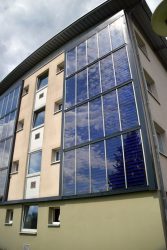With the funding announcement "Solar building / energy-efficient city"Together with the BMWi, the BMBF is providing up to 100 million euros over the next five years for research, development and Innovation in the field of sustainable urban development.
In the first round of calls for proposals, more than 60 consortia from city administrations, research institutes and companies applied for funding. Of these, the following six were selected:
- In Kaiserslautern show nine partners on the former Pfaff factory premises AGThe project shows how the energy turnaround can be successfully implemented in the neighbourhood with a high proportion of locally generated renewable energy and buildings that are to be renovated, listed and new.
- In Heather (Holstein) develop in the consortium "Quarree 100" twenty partners to find solutions for the deregulation of renewable energy and to use it sensibly locally - for example, the waste heat from electrolysis plants for the heat supply of existing buildings.
- In Oldenburg wants the project "ENaQ - Energetic Neighbourhood". In addition to electricity, heat and electromobility, it is above all the actors and users who must be networked with each other.
- In Zwickau is realized by a consortium of 13 partners in the project "ZED" an Zero Emissions Quarterwhich is intended to show how apartments can be supplied in a future-proof and affordable manner on the basis of electrical-thermal composite systems.
- In Esslingen the climate-neutral Urban quarter "ES-West P2G2P“ enable the cross-sectoral use of regenerative electricity surpluses through a network of innovative technologies. In the process, the district will be linked to the city's mobility concept via electric buses, for example.
- The project "City Quarter 2050 - Solving Challenges Together" will demonstrate in two southern German neighbourhoods how innovative building solutions can contribute to social compatibility in tight housing markets. For example, users of the buildings are involved in energy management through an interactive "neighbourhood app".
The projects are intended to show how energy consumption in urban quarters can be reduced, the intelligent network of electricity, heat and mobility and that renewable energies can be sensibly integrated into the energy supply.
Source: BMWi and BMBF PM of 11.7.2017
Keywords: DE-News, Energy storage, Renewable, Funding, Climate protection, Mobility, News Blog Baden-Württemberg, News Blog Lower Saxony, News Blog RLP, News Blog Saxony, News Blog Schleswig-Holstein, PV, PlusEnergy house/settlement, Quarters, Electricity storage, Environmental policy, eMobility





 The Institute for Solar Energy Research (ISFH) has presented a free tool for the individual design and holistic evaluation of tenant electricity concepts.
The Institute for Solar Energy Research (ISFH) has presented a free tool for the individual design and holistic evaluation of tenant electricity concepts.